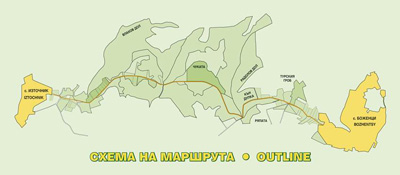
The eco path starts from the village of Bozhentsi and is about 8 km long. Since the founding of the village of Bozhentsi, the path has provided a short cut to Gabrovo. It has been well maintained through the ages.
Several stories are connected with this path. At the beginning of the 19th century, Bogdan from the village of Bozhentsi was a sailor in the British Navy. On his way home, he was attacked by thieves who robbed and killed him. The authorities, however, captured the thieves, and sent Bogdan’s horse, his ring and two horse-bags full of gold to his mother. Bogdan’s mother used some of the money to rebuild the road to Radolov Dol in memory of her son, so now this part of the road is called Bogdan’s cobblestone road.
Father Minyo, the Priest, a popular character in Gabrovo anecdotes also used to donate money for the maintenance of this road, as he himself walked along it barefoot so as not to wear out his shoes.
Near the village of Bozhentsi, a mere 10 meters off the road, you can still see Racho’s well. The well is named after the legendary son of the noblewoman Bozhana, Racho the Blacksmith, the founder of the town of Gabrovo.
Along the path there are cozy rest areas, with tables, benches, arbours and fire-places, as well as information boards providing maps of the route and information about the Roman Road.